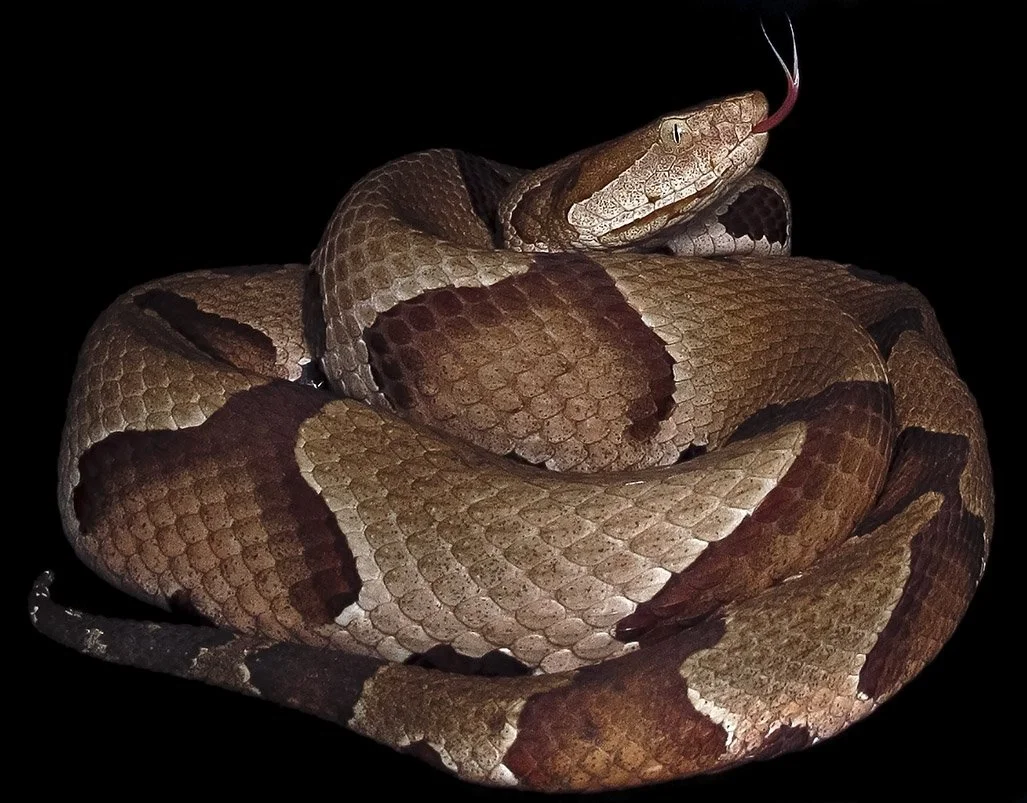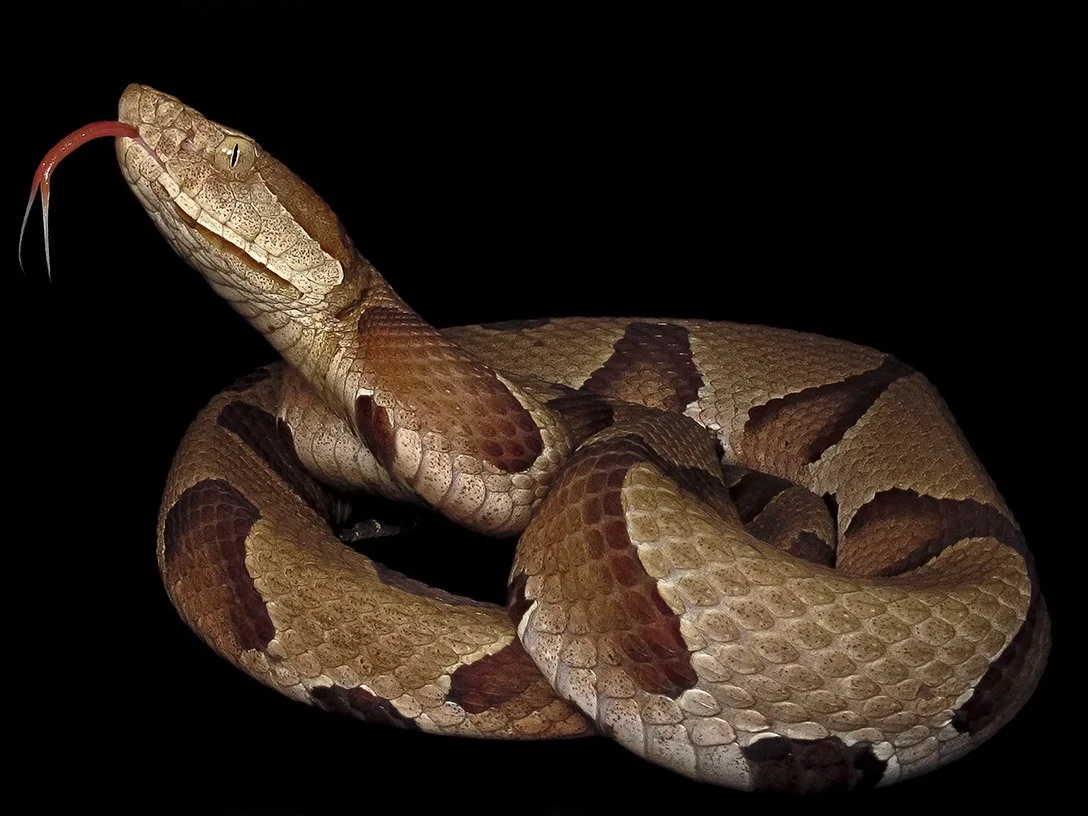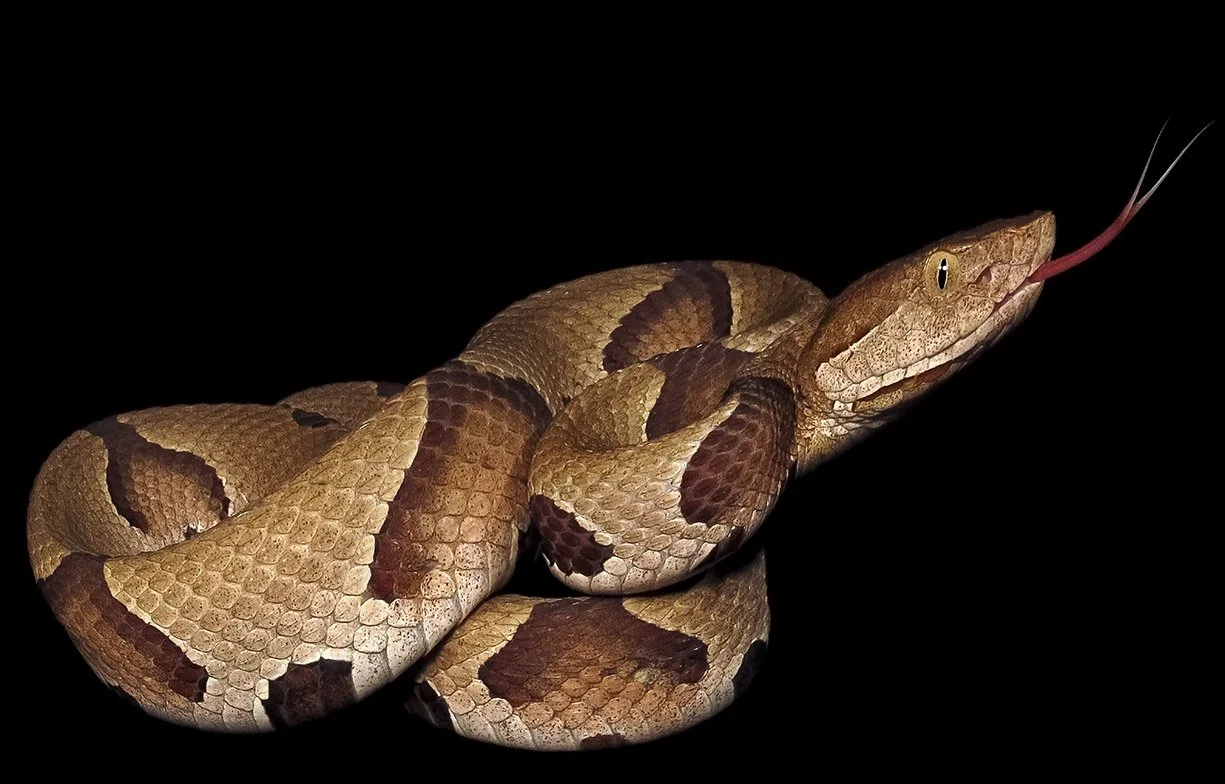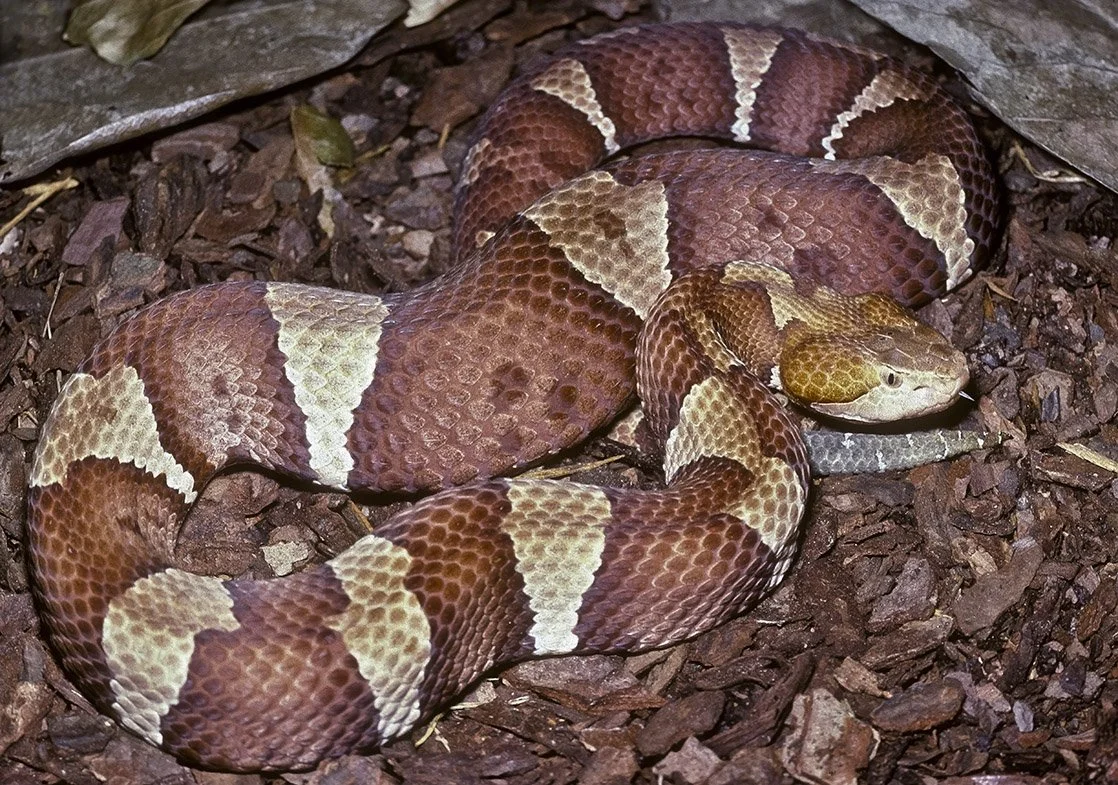Copperhead
Southern Accent, Secretive Neighbor
by William W. Lamar
Image: ©W. W. Lamar 2023.
I just found an especially pretty adult female Southern Copperhead (Agkistrodon contortrix) beneath an overturned wheelbarrow in my yard. I live on 25 heavily wooded acres in East Texas and this is only the fifth copperhead that has turned up during my 41 years of residence here. Obviously, there is a population, but they rank among the most cryptic of snakes so they’ve been successful at evading detection.
A multi-year mark-and-recapture study was conducted just north of my home at a small Nature Conservancy plot called “Sheff’s Woods.” Using drift fencing and funnel-entry traps, snakes were caught, marked, and released. Western Cottonmouths were so prone to re-entering these traps that it soon became possible to identify them from a distance. Copperheads? Never—not one single time—did a Copperhead get trapped more than once. And yet, the calculated density of Southern Copperheads per acre/0.40 ha there was between 85 and 105! I field-collected three Texas Coralsnakes (Micrurus tener) on that land but none of us ever observed a Copperhead unless it was in a trap.
Cryptic indeed!
Image: ©W. W. Lamar 2023.
Being old, fat, and inflexible, I hoisted this one up onto a table in order to take some pictures. Of course, this then necessitated subjecting her to one of my patented “Come-to-Jesus” chats wherein I try to convince the snake that cooperating and posing nicely is both a responsibility and a duty…for posterity’s sake. But the pitviper evidently hewed to the thinking of the late Groucho Marx, who once commented, “Why should I care about posterity? What's posterity ever done for me?” OK, so it was more a war of attrition. It required a lot of patience, some agility (of which I have precious little remaining), and, of course, luck.
So here she is, in all her glory…
While in the process of photographing her, I had a revelation of sorts. At risk of reprising the old, “I used to have to walk across nine feet of shag carpet in order to manually change the TV channels” rag, here goes: I recalled the way I started taking specimen pictures. I lived and worked in Colombia in the 1970s and took closeups of herptiles in order to document colors and patterns to accompany museum specimens. Kodachrome, the go-to film for such things, was in extremely short supply so I parsed my shots. I took notes to accompany each photo, carefully packed the exposed roll, walked with it downtown, stood in a long line at the post office, and mailed it to Atlanta, Georgia, USA, for processing. Exactly 21 days later I got the slides, immediately labeled everything and, of course, learned which ones I had ruined. By then it was too late for a do-over, so the stakes were rather high.
Here’s the thing that struck me: After taking a series of shots, with this copperhead still on the table, I pulled the memory card from the little camera, plugged it into the computer, and brought everything up on the big monitor to check things over and see if they were OK. Then I slipped the card back into the camera and continued. No costly film, no lines at the post office, no delay. Geez! What a long, long way we’ve come since the days of film photography!
Image: ©W. W. Lamar 2023.
After I took enough shots to allow for my ever-present screw-ups, I again went to the computer.
The massive convenience of using a cheap little Canon point & shoot camera (or, for that matter, a cell phone) brings a few deficiencies and one of them is what I call dropped pixels. That leaves little rectangular blank places here and there. And just think, pixels didn’t even exist back when we used film cameras. Well, actually they did, but mostly for folks at NASA or in Palo Alto. Anyway, a pixel is the smallest unit of a digital raster image. In terms of photo quality, the more the merrier. With my little camera (workhorse though it is) there just aren’t enough to go around, so I have to look each picture over and see what sort of patching up might need doing.
Now, I do have a big-boy camera and lens but I am too lazy to haul them out. And, wading through the excess of options and controls is no fun at all. Undoubtedly, using this setup would obviate much of the cleanup work, not to mention result in better quality images.
Image: ©W. W. Lamar 2023.
But I don’t mind. Actually, this little camera is kinda fun.
And in the process of doing this triage and cleanup, it enhances the experience of getting a long, close look at the animal…which is what it’s all about anyway. And in the process, the Copperhead got the chance to have a nice, long look at me.
I realized I wasn’t the only one with binocular vision.
Image: ©W. W. Lamar 2023.
I came away from this impromptu meeting appreciating her lovely colors and cryptic pattern more than ever. And I took her right back to the overturned wheelbarrow she knew so well. I also learned that Southern Copperheads are not very civic-minded…my camera got all chewed up!
Image: ©W. W. Lamar 2023.
A Few More
Broad-banded Copperhead, Agkistrodon laticinctus, Johnson County, Texas, USA. Image: ©W. W. Lamar 2023.
Southern Copperhead, Agkistrodon contortrix, Collin County, Texas, USA. Image: W.W. Lamar 2024.
Southern Copperhead, Agkistrodon contortrix, Natchez Trace, Mississippi, USA. Image: ©W. W. Lamar 2023.
Broad-banded Copperhead, Agkistrodon laticinctus. Image: ©William B. Montgomery 2023.
Southern Copperhead, Agkistrodon contortrix, southern Mississippi, USA. Image: ©W. W. Lamar. 2023.
A handsome pair of captive Broad-banded Copperheads, Agkistrodon laticinctus, from Johnson City, Blanco County, Texas, USA. Image: ©W. W. Lamar 2024.
Neonate Southern Copperhead, Agkistrodon contortrix, from southern Mississippi showing the characteristic sulfur yellow tail observed in youngsters. Image: ©W. W. Lamar 2024.
All content ©Exotica Esoterica LLC® 2023 and ©William W. Lamar 2023.
Follow us on:

















